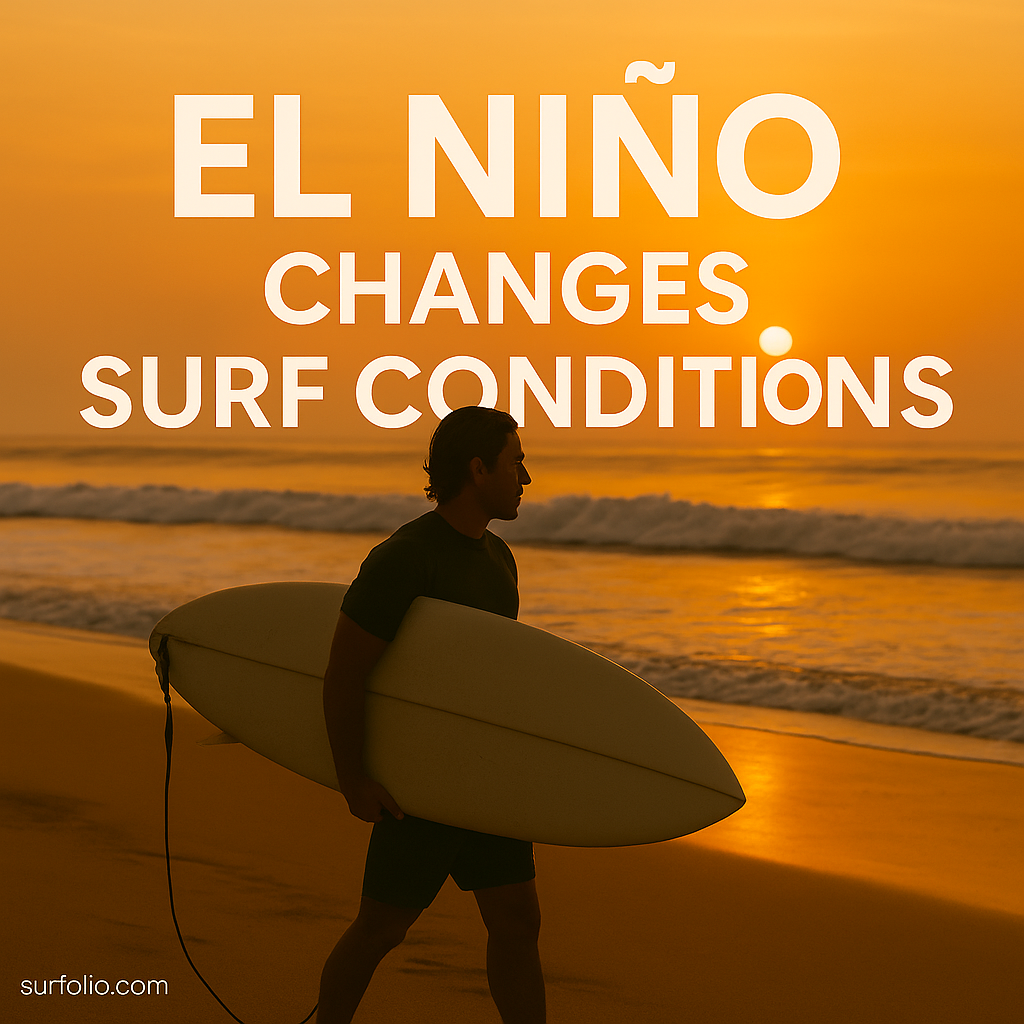
Every few years, the world’s oceans shift in rhythm—triggering a phenomenon that transforms weather patterns, wave behavior, and surf conditions across the globe. It’s called El Niño, and for surfers, it can be both a blessing and a curse.
El Niño’s effects ripple across coastlines, influencing swell consistency, wind patterns, and even water temperatures. Understanding how this system works helps surfers anticipate conditions and plan trips more strategically.
What Is El Niño?
El Niño is part of a larger climate cycle known as the El Niño–Southern Oscillation (ENSO), which alternates between three phases:
- El Niño (warm phase) – Ocean waters in the central and eastern Pacific become unusually warm.
- La Niña (cool phase) – These same waters become cooler than normal.
- Neutral phase – The system returns to balance.
During an El Niño event, weakened trade winds allow warm water to shift eastward across the Pacific, altering atmospheric pressure and ocean circulation on a global scale. The results are dramatic: droughts in some regions, floods in others, and major shifts in storm and swell activity.
How El Niño Affects Surf Conditions
1. Bigger, More Powerful Swells in the Pacific
El Niño fuels more frequent and intense storms in the North Pacific, producing massive swells that light up breaks in California, Hawaii, and Central America.
- Famous spots like Mavericks and Pipeline often see record-setting waves during these years.
- However, local conditions can be unpredictable—offshore winds and tidal shifts vary widely from storm to storm.
2. Warm Water Temperatures and Longer Surf Seasons
The warm-water shift means wetsuits become optional in regions that are normally chilly.
- In California, water temperatures can rise 5–10°F (2–5°C) above average.
- This can extend the surfing season and improve comfort, though it also attracts tropical marine life (like jellyfish or sharks).
3. Storm-Driven Chaos in the Western Pacific
While the eastern Pacific thrives on epic waves, Australia and Indonesia often face less consistent surf.
- Trade winds weaken, resulting in fewer perfectly groomed swells.
- Rain and onshore winds may make surf conditions messy or unpredictable.
4. Coastal Erosion and Beach Break Changes
With more frequent storm activity and larger waves, beach morphology can change drastically.
- Sandbars shift, shorelines retreat, and certain breaks can vanish or reform entirely.
- Surfers may find new peaks in familiar spots—or lose favorites to erosion.
5. Opportunities for Unusual Swell Windows
El Niño events can open up rare surf opportunities in places that rarely see quality waves, like Mexico’s Gulf Coast or South America’s normally calm regions.
- Chile, Peru, and Ecuador often experience stronger swells and warmer water.
- The key is adaptability—following swell forecasts closely and being ready to chase unusual setups.
Global Surf Hotspots Most Affected by El Niño
Pacific Ocean (Big Winners)
- California – Massive North Pacific swells and warmer water.
- Hawaii – Larger, more frequent waves on the North Shore.
- Central & South America – Consistent swell activity and tropical warmth.
Western Pacific (Challenging Conditions)
- Indonesia – Unreliable winds and fewer long-period swells.
- Australia – Cyclone activity shifts, reducing wave quality in some regions.
Other Affected Areas
- Africa’s East Coast – May experience warmer seas and slightly altered swell patterns.
- Pacific Islands – More stormy, with variable conditions depending on location.
How Surfers Can Prepare for El Niño
1. Follow Climate and Swell Reports
Sites like NOAA and Surfline release ENSO forecasts months in advance. Watching these can help you plan upcoming trips around changing swell seasons.
2. Adjust Your Quiver
- For larger waves: bring step-up or big-wave boards.
- For inconsistent or unpredictable surf: pack a versatile mid-length or hybrid.
3. Expect the Unexpected
El Niño conditions fluctuate throughout the season. A break that’s usually mellow could suddenly turn into a heavy reef barrel—so approach new conditions with respect and caution.
The Bottom Line
El Niño is nature’s wildcard. It reshapes the world’s surf landscape—amplifying power in some regions while calming others. For surfers, it’s a reminder of how deeply the ocean connects global weather, climate, and community.
Understanding El Niño means more than chasing waves—it’s about learning to flow with nature’s cycles, appreciating how every swell tells a story from thousands of miles away.
So next time you’re paddling into a giant winter swell or basking in unusually warm summer water, remember: El Niño is out there, shaping the rhythm of every wave you ride.
